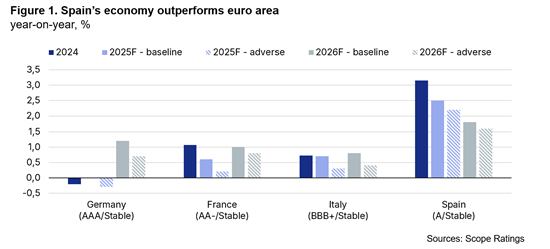Announcements
Drinks
Spain’s growth holds firm amid US trade policy shifts, but fiscal restraint key for debt trajectory
By Jakob Suwalski and Brian Marly, Sovereign and Public Sector Ratings
We maintain our baseline forecast for Spain’s GDP growth at 2.5% in 2025 (A/Stable) despite the slowdown in global growth and the uncertainty surrounding the trade and tariff negotiations with the US. The reassuring near-term outlook is supported by stronger-than-expected growth last year (3.2%) and solid Q1 momentum.
However, our outlook for 2026 is more conservative (Figure 1). We expect real GDP growth to slow to 1.8% in line with the country’s estimated medium-term potential, as some of the factors driving growth fade and tighter fiscal policy becomes necessary to further reduce the budget deficit.
Spain moderately exposed to US policy shift, vulnerable in specific sectors
Today’s robust growth cannot disguise the economy’s vulnerabilities particularly in an adverse scenario of substantial, longer-lasting increases in US tariffs and broader retaliation from trading partners. Spain’s export-oriented automotive sector – Europe’s largest after Germany’s – would likely be particularly impacted in such a scenario.
In this adverse scenario, growth would slow to 2.2% in 2025 and 1.5% in 2026 on weaker external demand and euro area industrial stagnation. Spain would also be vulnerable to indirect consequences of a full-blown trade war from reduced tourism and investment, if a US recession and slow European growth curb cross-border activity.

Labour market, EU funds, strong tourism, low Russian exposure, and real estate developments underpin economic growth
Multiple factors explain Spain’s robust growth this year.
First, the labour force is expanding rapidly, supported by high immigration, mainly from Spanish-speaking South America. Earlier reforms have enhanced labour-market flexibility. Social security registrations have surged, partly reflecting behavioural shifts since the pandemic, when formal employment enabled workers’ access to state support. Together with digitalisation – Spain has Europe’s highest household fibre take-up rate – this has led to the shift away from informal employment, even if the trend seems to be flattening out.
Secondly, the disbursement of EU recovery funds, equivalent to 11% of GDP, continues to spur investment in Spain and support growth. Spain has executed EUR 49bn or 64% of its EUR 163bn allocation by end-March. Annual execution remained relatively stable, with 2024 disbursements slightly below the previous year but above those of 2022. We expect the remaining funds of about EUR 123bn to be assigned to projects until 2026 and subsequently disbursed.
Thirdly, tourism remains buoyant, as instability and inflation in competing destinations like Egypt and Turkey (BB-/Stable) help attract foreigners to Spain.
These trends should allow for a continuation of the broad-based growth recorded in 2023-24, with private consumption and investments expected to pick up pace as services exports and government consumption growth normalise. Robust economic growth should also help maintain the positive dynamic in labour market outcomes, with the unemployment rate at multi-decade lows (10.6% in Q1 2025).
Spain’s limited trade and energy ties with Russia helped insulate it from the initial economic impact of the war in Ukraine (rated SD) while strengthened renewable energy capacity, supported by EU fund implementation, contributed to stable and comparatively lower energy prices than in other large European economies. Recent infrastructure strains and low defence spending point to investment needs that, if addressed, could enhance resilience and support long-term growth, but pressure public finances.
Looking ahead, the real estate sector could emerge again as an important growth driver due to strong underlying demand, structural supply constraints, and supportive financing conditions given the ECB’s loosening monetary policy, with incremental rate cuts expected throughout the year.
Spain’s immigration-led population growth has intensified the country’s housing shortage, especially in cities and the coast. Private sector deleveraging since the 2008 crisis has left corporate and household debt below the EU average, providing them with comfortable headroom to invest. Continued housing-market momentum could lead to better-than-expected GDP growth in the future.
Fiscal outlook: progress, risks, and the need for structural adjustment
Spain has used its substantial EU funding to invest in infrastructure and green energy, supporting growth while enabling gradual fiscal consolidation. The budget deficit peaked at around 10% of GDP in 2020 during the pandemic and declined to 3.2% in 2024.
With public debt at 102% of GDP and net interest payments at 1.8% of GDP in 2024, Spain's fiscal space remains constrained, particularly if the US trade war intensifies. Assuming no significant shocks, we expect the fiscal deficit to decline modestly to 2.5% of GDP and debt to decline further to around 92% of GDP by 2030.
We expect the decline in the fiscal deficit to decelerate as revenue growth is set to slow in line with lower economic growth. For this reason, the commitment to limit annual expenditure growth to below 3%, against projected nominal GDP growth of 4%, is an important sign of the fiscal discipline needed to enhance the resilience of Spain’s public finances.
The government’s recently announced EUR 14bn support package in response to tariff risks –comprising EUR 7bn in ICO (A/Stable) credit lines, EUR 5bn in EU fund reallocations, and temporary labour market support – is unlikely to materially impact public finances or macro-economic outcomes.
Scope’s next scheduled review date for the Kingdom of Spain is 18 July 2025.
Make sure you stay up to date with Scope’s ratings and research by signing up to our newsletters across credit, ESG and funds. Click here to register.






